20% Off USA-Made All-Metal Greenhouse Kits until May 31
20% Off USA-Made All-Metal Greenhouse Kits until May 31
High Tunnel vs Caterpillar Tunnel: Which one is right for you?
January 16, 2025 7 min read 0 Comments
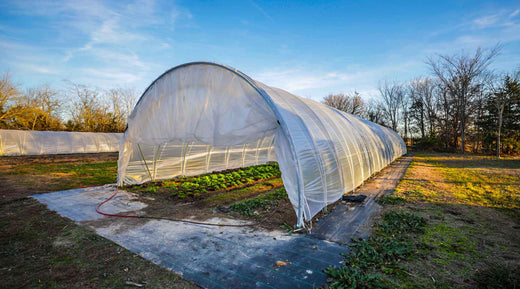
What's the difference between a caterpillar tunnel and a high tunnel?
The difference between a caterpillar tunnel and a high tunnel comes down to three things- permanence, structural soundness, and budget. Both structures have their place in the gardening world, but they have sharp differences that need to be accounted for by the grower.
Using covered growing spaces for season extension is a time-honored, low-cost practice that extends the growing season for farmers and gardeners in almost any growing zone. While greenhouses are expensive infrastructure and cold frames are too small for market gardeners, tunnels are a happy medium that offer multiple opportunities.
Caterpillar tunnels allow you to:
- Fall plant cool season annuals for early flower production
- Protect early Spring greens for first-to-market possibilities
- Extend harvests into the heat of the Summer with added shade cloth
- Add degrees of protection in late Fall for cold hardy crops
- Warm the ground for early planting of summer market favorites like tomatoes, cucumbers and melons
- Release and contain beneficial insects for pest control
- Protect delicate flowers and produce from hail or rain
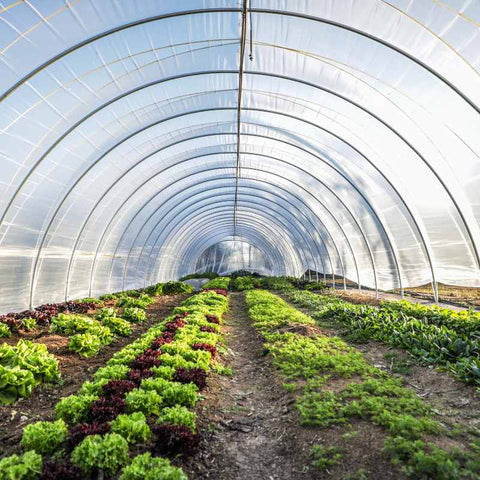
The caterpillar tunnel, or CAT tunnel, received its name because of its close resemblance to a caterpillar. The typical design has segmented sections and cone-shaped ends that hug the ground at either end, usually held together by a stake and a rope.
Bootstrap Farmer’s take on the caterpillar tunnel, includes butterfly doors with a clamshell design that is easy to operate. These unique doors eliminate the need to bunch loose plastic at the ends and the constant tying and untying from the stake.
The plastic is secured by side-to-side crisscrossing of nylon strapping or rope anchored to the base of each pole (where they touch the ground). It does not have built-in end walls and is often considered a temporary/movable option, making it one of the cheapest and quickest crop protection options to build. Many market gardeners use it as a starting point, then later convert the caterpillar tunnel into a high tunnel greenhouse or build a high tunnel as their next structure.
On the other hand, a high tunnel or hoop house has end walls, doors, and sidewalls. Instead of a rope system, the structure is secured by metal base and hip boards, side braces, and purlins. The hoop house is then anchored to the ground by heavy-duty metal ground posts. The plastic is secured by metal lock channel and PVC spring wire, giving more stability and reliability.
With the installation of hand cranks, the plastic sidewalls can be made to roll up and down, allowing for easy ventilation. This type of infrastructure is an investment meant to last for many years as they are a more durable and versatile option. Read more about how to build hoop houses in this article on what you need to know before you start.
Greenhouse coverings for use with caterpillar tunnels and high tunnels.
There are a variety of options when it comes to covering your hoop building. The most prevalent greenhouse coverings are:
- UVA protected 6 mil. plastic sheeting
- Silage tarps for light deprivation
- Thick woven 8 mil. or 11 mil. plastic for heavy weather
- Insect netting on roll-up sides
- Shade cloth
How much do caterpillar tunnels cost?
A basic caterpillar tunnel can be built for under $5.00 per square foot. This reflects the recent dramatic increases in raw materials costs that we have seen across the industry in recent years.
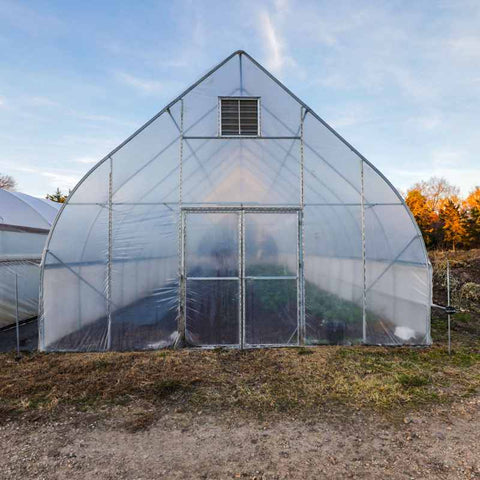
How much do high tunnels cost?
A small DIY hoop house kit like this, can be an affordable starting point for small farms for season extension. The lower price reflects the sweat equity you will put in on the build. You can buy a small 10’x20’ kit for under $500 and a large 20’x100’ for around $1,600 to be built with additional materials purchased from your local hardware store. The cost of locally purchased items like poles for bending hoops and lumber for building end walls can vary greatly depending on location and demand.
If you are looking for a more heavy-duty, all-metal hoop house, you can buy all-inclusive kits like these without needing supplies from your local big box store. These structures are much simpler to build and far more sturdy than any built with lumber.
Due to the reliability of these structures, the USDA has put into place a grant program to help alleviate the investment costs of adding hoop houses to a farm’s operation. This program called the NRCS High Tunnel Initiative, funds qualifying hoop houses for many growers nationwide. Because this infrastructure can sustainably extend the growing season for many farmers, it helps increase food security. Because it improves and protects soil conditions, it is supported by funds set aside for soil conservation.
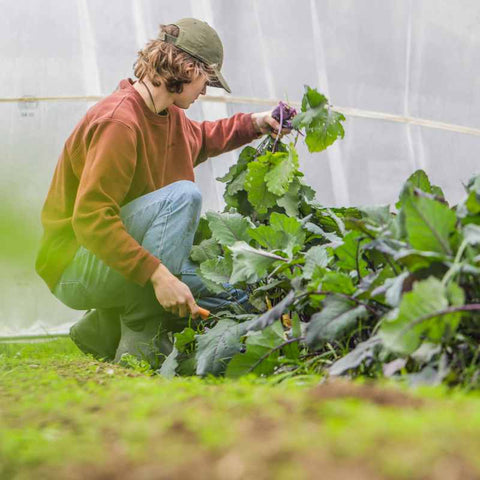
What are caterpillar tunnels used for?
Caterpillar tunnels in their simplest form are structures used for season extension as a temporary covered growing space for crops in production. They are often used to warm soil temperatures to prepare for spring planting. Flower farmers plant their early bulbs under caterpillar tunnels to get a jump start on growing that lets them bring their flowers to market sooner. Vegetable growers take advantage of the cover and warmer soil temps both early and late in the season for their production.
Tunnels covered with greenhouse plastic are often used to continue growing frost-hardy plants with a layered frost blanket through the winter months. Vegetable crops like kale and broccoli that will be harvestable in the cold can be protected from snow in this way so that you can access them for harvest. For flower farmers, planting cool season annuals like snapdragons and bachelor buttons in the Fall and covering them with low tunnels allows the plants to develop roots through the Winter and be ready to take off as soon as the weather warms.
Caterpillar tunnels covered with shade cloth are used in the hotter months to protect tender crops from excess heat. They are also used in this way to protect fruiting crops like tomatoes and cucumbers from sunscald.
Related: Guide to Using Shade Cloth

How to anchor a Caterpillar tunnel
Caterpillar tunnels can be anchored with rebar, ground posts, sand bags or with a rope system secured with a t-post. This method will be dependent on the permanence you desire from the structure. Our research with farmers found that most prefer a more permanent placement because of the stability improvement. The trade-off of easy disassembly and moveability is far outweighed by the piece of mind in high winds and extreme weather. This is why our caterpillar tunnel kits come with ground posts and additional bracing.
How to Reduce the Chance of Wind Damage to a Caterpillar Tunnel
A great way to reduce wind damage to a caterpillar tunnel is to attach the plastic securely. Take care to stretch and resecure your plastic and tighten the strapping as a maintenance item. You may also want to consider installing wind bracing to the structure. Caterpillar tunnels are often vulnerable to wind because of the “parachute” effect that occurs when the wind gets under the structure, so it is crucial to have it anchored to the ground and use sand bags to hold down the plastic and the doors when storms are on the horizon.
What can I grow in a caterpillar tunnel?
When planted at the right time, you can grow just about anything in a caterpillar tunnel. Caterpillar tunnels can be used for late-season extension on brassicas and other cold hardy crops or to allow you to start your Spring greens and root crop season earlier. They work well to warm the ground for earlier planting and protect new plants from late spring frosts. CAT tunnels also increase temperatures in the summer for heat-loving crops. Closing the doors every night helps to balance day/night temperature swings for more productive vining crops.
Cool-season annual flowers planted in caterpillar tunnels can overwinter for super early Spring blooms. Delicate flowers that do not tolerate wet petals are protected from rain inside the tunnel. Bulbs will also flower earlier and benefit from more controlled watering. In the heat of Summer, the addition of shade cloth will keep your flowers blooming even in heat waves.
In areas with heavy snow loads, you may need to remove the plastic from your tunnel to protect the integrity of the structure.
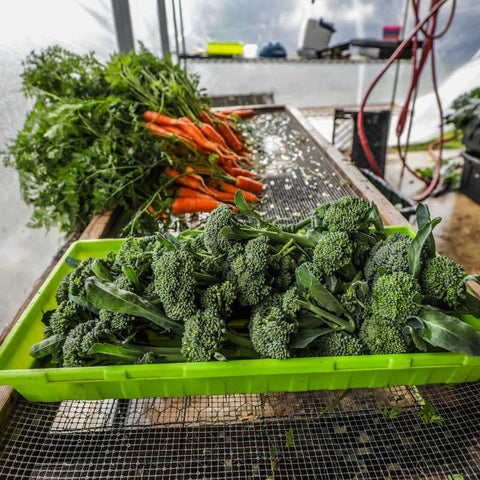
What can I grow in a high tunnel?
The short answer is almost anything can be grown in a high-tunnel greenhouse. A high tunnel gives the grower more assurance to grow even later into the season than a caterpillar tunnel. The durability of the metal frame is enough to protect from snow and wind that comes with the fall season in some growing zones. Vegetable crops and flowers have ample space and protection under a tunnel. Read more about the benefits of high tunnels in this article.
Should I buy a Caterpillar Tunnel or a Hoop House?
Whether to buy a caterpillar tunnel or hoop house to create a covered growing space depends on your farm's needs. While the caterpillar does have a smaller startup cost, the stability and reliability of the structure do not meet that of a high tunnel. Both structures need to be shipped freight and require help to build. If you believe you will need something sturdier in the future, spending more upfront on a complete high tunnel may be a better investment. The caterpillar tunnel may be perfect if you are growing in a mild climate that does not experience snow.
You can also invest in a caterpillar tunnel as your first structure. The added revenue that earlier and later crops bring, as well as the increased price you can get for more perfect produce, can be used to finance your next big step.
To learn more about how flower farmers and market gardeners are using high tunnels and other covered growing spaces, follow us on Instagram and subscribe to our YouTube channel. We love to feature stories about how our customers are rocking it on the farm.
Subscribe
Sign up to get the latest on sales, new releases and more …
